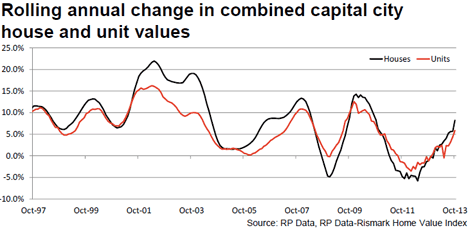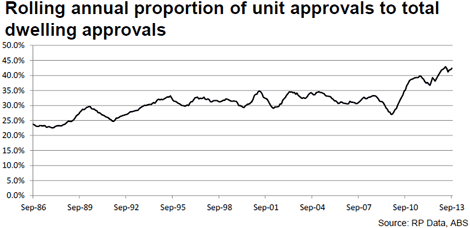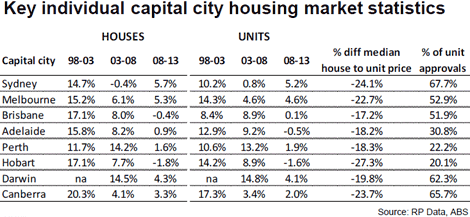Detached houses overtake units as the best performers in capital city markets
Detached houses have now superseded units as the best performers across the capital city property markets. Up until recently unit values were showing a much stronger performance.
Across Australia’s combined capital cities over the 12 months to October, houses grew in value by 8.2% as opposed to units at 5.9%.
There’s a commonly held view that house values appreciate at a more rapid pace than unit values due to the underlying land value however, this has not necessarily been the case throughout most of the past five years.

These results show that capital city values over the past five years to November 2013 increased at an average annual rate of 3.7% compared to growth of 4.0% per annum across the unit market. If we look at the two previous five-year periods we see that growth in house values outstripped unit values.
Between October 1998 and October 2003, house values rose by 15.0% each year compared to unit value growth of 11.1%. Between October 2003 and October 2008 house values increased at an average annual rate of 4.9% compared to 3.6% for units.

Strong growth in house values over the preceding two five-year periods highlights a time when houses were typically favoured over units. However, with current mortgage rates extremely low, buyers are potentially stretching themselves financially in order to purchase a detached house rather than a unit.
It will be interesting to see if the higher level of growth reverts to units in Sydney and Melbourne over the coming year as selling prices rise and affordability becomes more challenging for detached housing.
Once we see start to see a rise in interest rates, we may also see the dynamics shift.

Based on these results, one of the reasons why value growth has been more closely aligned between houses and units over the past five years comes down to affordability factors.
The median selling price for a unit has consistently been between 10 and 15% lower than that of a house since early 2006.
Although this may not sound significant, the current difference is 14.8% which equates to $80,000 across the combined capital cities which is much more than a year’s average wage.
Dwelling approvals data shows that over recent years, there has been a sharp escalation in the proportion of approvals for higher density product as opposed to houses. I expect this trend to continue, largely due to the lower prices of units and increasing demand for people to live in inner city areas which are close existing transport infrastructure.

Based on dwelling approval data over the 12 months to September 2013, 42.4% of all dwelling approvals were for units as opposed to houses. Although houses account for the majority of dwelling approvals, the proportion of unit approvals has increased from:
• 38.9% in 2012
• 33.2% in 2007
• 34.2% in 2003
• 29.6% in 1993.
Dwelling approvals data over the past 12 months across the capital cities shows that higher density living in our major capital cities will be a central feature into the future. More than 50% of all approvals in Sydney, Melbourne, Brisbane, Darwin and Canberra were for units as opposed to houses over the 12 months to September 2013.
Although many people have aspirations of owning a house as opposed to a unit, in reality it’s becoming more and more difficult. Added to this is that affordable housing tends to be quite a distance from CBD area. As a result we are seeing a rising prevalence of higher density construction in our major capital cities, particularly within inner city areas.
Current market conditions may lead to stronger demand from both investors and tenants and subsequent stronger levels of value growth for units as opposed to houses over the coming years.
Cameron Kusher is senior research analyst at RP Data.